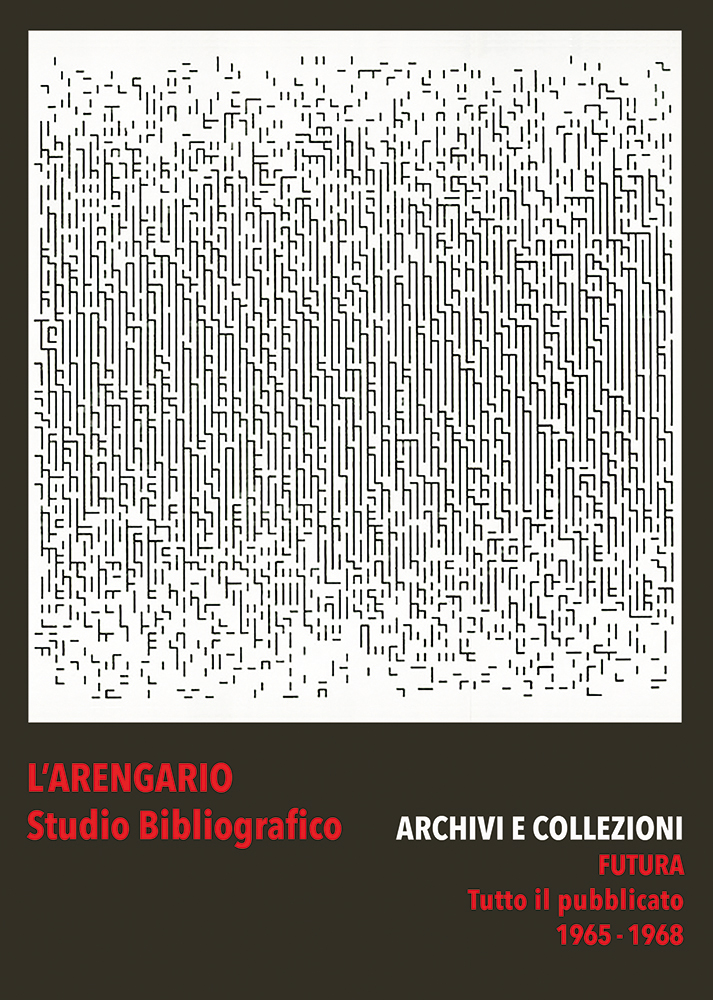L'ARENGARIO STUDIO BIBLIOGRAFICO - Dott. Paolo Tonini
Futura. Tutto il pubblicato (1965 - 1968)
Luogo: Cellatica
Editore: L'Arengario Studio Bibliografico "Archivi e Collezioni"
Stampatore: prodotto in proprio
Anno: 6 gennaio 2025
Legatura: brossura
Dimensioni: 29,7x21 cm.
Pagine: pp. VI - 26 (2)
Descrizione: copertina illustrata con un'opera di Frieder Nake («Computer Graphic»). Catalogo illustrato in nero e a colori, 26 schede ragionate con la riproduzione di tutti i numeri che compongono la collezione completa della rivista/manifesto FUTURA. A cura e contesto introduttivo di Paolo Tonini («Una strana bellezza» / «A strange beauty»). Edizione digitale.
Bibliografia: N. D.
Prezzo: N. D.ORDINA / ORDER
"La rivista FUTURA, pubblicata a Stoccarda da Hansjorg Mayer in 26 numeri dal 1965 al 1968, non è soltanto la prima in forma di manifesto ma anche la prima pubblicazione di poster d’artista, anticipando idealmente i manifesti delle edizioni ED912 di Gianni Emilio Simonetti e Gianni Sassi. Gli autori coinvolti sono artisti e poeti d’avanguardia in gran parte dell’area Fluxus, attivi nell’ambito di ricerca della poesia concreta e sonora. I riferimenti letterari espliciti sono Edward E. Cummings, Ezra Pound, James Joyce, quelli sottaciuti sono il futurismo italiano e lo Eliot de «La terra desolata». Nello spazio bianco (come in una terra desolata) si installano caratteri organizzati in parole e strutture geometriche essenziali. In alcuni casi la figurazione è finalizzata alla dizione dei versi (idea già sperimentata da Lissitzky nel Dlja Golosa di Majakovskij nell’edizione berlinese del 1923), in altri è evidente la consonanza con le «parole in libertà» e la sperimentazione tipografica futuriste. E’ una strana bellezza. La parola che si espande e risuona in quello spazio si carica di ogni possibile significato: è uno spazio mentale che si toglie dal tempo e che oscura l’orrore della storia: si apre a un futuro ancora possibile" (dal testo introduttivo).
The magazine FUTURA, published in Stuttgart by Hansjorg Mayer in 26 issues from 1965 to 1968, is not only the first in the form of a manifesto but also the first publication of artist posters, ideally anticipating the posters of the ED912 editions by Gianni Emilio Simonetti and Gianni Sassi. The contributors are avant-garde artists and poets, mostly from the Fluxus movement, active in the realm of concrete and sound poetry. Explicit literary references include Edward E. Cummings, Ezra Pound, and James Joyce, while implicit ones are Italian Futurism and Eliot’s «The Waste Land». In the white space (as in a wasteland), characters are arranged in words and essential geometric structures. In some cases, the figuration serves the enunciation of the verses (an idea already experimented by Lissitzky in «Dlya Golosa» by Mayakovsky in the 1923 Berlin edition), while in others, there is a clear resonance with the «words in freedom» and the typographic experimentation of the Futurists. It is a strange beauty. The word that expands and resonates in that space is charged with every possible meaning: it is a mental space that detaches itself from time and obscures the horror of history, opening up to a still possible future".
DISPONIBILE IN VENDITA: collezione completa di tutto il pubblicato, costituito da 26 fascicoli numerati da 1 a 26: € 2.600
DOWNLOAD PDF FILE
The magazine FUTURA, published in Stuttgart by Hansjorg Mayer in 26 issues from 1965 to 1968, is not only the first in the form of a manifesto but also the first publication of artist posters, ideally anticipating the posters of the ED912 editions by Gianni Emilio Simonetti and Gianni Sassi. The contributors are avant-garde artists and poets, mostly from the Fluxus movement, active in the realm of concrete and sound poetry. Explicit literary references include Edward E. Cummings, Ezra Pound, and James Joyce, while implicit ones are Italian Futurism and Eliot’s «The Waste Land». In the white space (as in a wasteland), characters are arranged in words and essential geometric structures. In some cases, the figuration serves the enunciation of the verses (an idea already experimented by Lissitzky in «Dlya Golosa» by Mayakovsky in the 1923 Berlin edition), while in others, there is a clear resonance with the «words in freedom» and the typographic experimentation of the Futurists. It is a strange beauty. The word that expands and resonates in that space is charged with every possible meaning: it is a mental space that detaches itself from time and obscures the horror of history, opening up to a still possible future".
DISPONIBILE IN VENDITA: collezione completa di tutto il pubblicato, costituito da 26 fascicoli numerati da 1 a 26: € 2.600
DOWNLOAD PDF FILE

